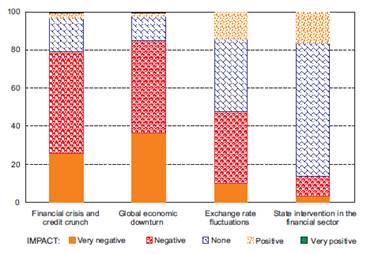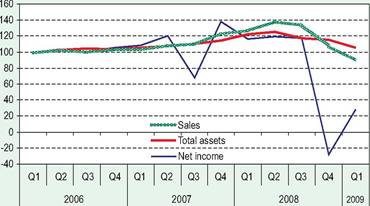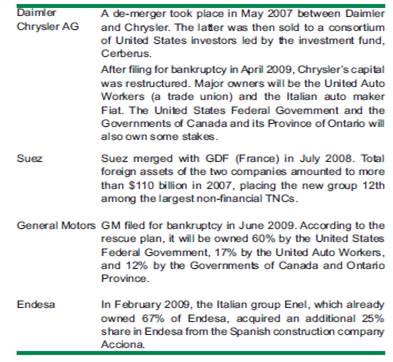The main reason leading companies to internationalize their assets are: achieving higher profits with low costs and of enhanced profitability. This can be achieved by exploiting opportunities offered by other countries with cheaper raw materials and human resources, by the penetration of more advantageous markets for export. Not at least, among the positive effects of capital and technology exports are repatriating their earnings as profit in the origin countries of TNCs.
However, many scientists try to show the dependence between migration and trade. They say that determining the volume of trade without taking into account migration, it is not objective. Testing in some small economies shows that there is dependency between export and migration.
The practice of international labor migration has emerged as a spontaneous phenomenon but, with the development and intensification of the process, began to be regulated by the state. However, currently are not liquidated all features of this process.
The last decade of the XX century is characterized by the fact that importing countries and exporting countries of labor force introduce radical correction in their migration policy. As world practice shows, workers migration provides indisputable advantages to the countries: for those providing employment as for those who receive it.
For the control of migration processes, states have begun to introduce so-called migration rates. Labor force - importing states, taking into account the real needs and labor market situation, determine the number of labor resources to be imported.
The goal of migration policy of the exporting countries is that labor force migration should increase the reduction of unemployment, receipt of foreign funds from immigrant workers, i.e. remittances, which is used for balancing imports - export operations. But sometimes, there may appear acute economic and social problems. Positive consequences of labor force migration:
- settling the problem of unemployment;
- the emergence of additional sources of income from migrants for exporting countries;
- obtaining the knowledge and experience by the immigrants;
- investment income of immigrants in small business, favoring the opening of new jobs.
Negative consequences of immigration workers:
- the trend of increase in consumption funds obtained abroad.
- the tendency to hide income;
- "brainwashing".
- decrease the qualification of unemployed immigrants.
- However, both for countries of origin as for TNCs host countries, in addition to the earnings of the process of globalization, there are also losses. The transfer to other countries of a part of the assets of TNCs contributes to job losses and rising unemployment in countries of origin. Moreover, labor productivity growth through technology transfer, information, innovation in firms purchased by foreign investors, brings with it an increase in unemployment in the host countries, in particular for unskilled or low skilled labor force. Host countries are frustrated that research and development operations are in countries of origin of TNCs, and technological innovations aren’t implemented simultaneously in the host countries.
- Workforce in developing countries means, for industrial countries, providing some branches and infrastructure with needed workers, without which it is impossible a normal industrial process, and sometimes normal everyday life. For example, in France, migrants make up 1/2 of total employment in construction, 1/3 - in the car industry, in Belgium - half of the miners, in Switzerland - 2/5 of the construction workers.
- As mentioned above, one of the key features of the process of globalization is the movement or free flow of capital. In addition, current global trade regime under WTO auspices provides unique possibilities for movement and reallocation off funds. Transnationalization of the world takes place differently in each country. Some countries have more foreign capital, others less. The trend that it is observed today is that where foreign capital is moving there will focus large flows of people.
- Even if corporations come in underdeveloped countries, they don’t offer great benefits to employees; on the contrary, they came just as attracted by low wages and slave pyramid style of local systems. Citizens of third world are seeking to reach the West, believing that they perform the same work more and will gain more money. Their surprise occurs when, once arrived in Europe, all companies have their production moved to countries where they originally came, now they must re-orientate or accept jobs below their qualifications.
Although the products are cheaper because they are performed in countries where production costs are minimal, this migration of labor force generates unemployment in developed countries and, therefore, the remaining unemployed have no money to buy products even so not cheap. Forbes magazine has published a study showing that Detroit will disappear in the next 20 years, this outsourcing and refurbishment made that unemployment in this city to be enormous, and now crime is at unimaginable odds. From a towering American city - king of the automobile production, with millions of habitants - now have left only 900 thousand people.
3. THE TENDENCIES OF TRANSNATIONAL CORPORATIONS’ DEVELOPMENT IN POST-CRISIS PERIOD
3.1 Modern tendency of TNCs’ development during the crisis
Today there are about 82,000 TNCs worldwide, with 810,000 foreign affiliates in the world. These companies play a major and growing role in the world economy. For instance, exports by foreign affiliates of TNCs are estimated to account for about one third of total world exports of goods and services. And the number of people employed by them worldwide, which has increased about fourfold since 1982, amounted to about 77 million in 2009 - more than double the total labor force of a country like Germany.
The largest TNCs contribute to a significant proportion of total international production by all TNCs, both in developed and developing economies. Over the three-year period 2007-2009, on average, the 100 largest non-financial TNCs accounted for 9%, 16% and 11%, respectively, of the estimated foreign assets, sales and employment of all TNCs in the world. They also accounted for about 4% of world GDP, a share which has remained relatively stable since 2000. This section analyses the major trends and recent developments with respect to the largest TNCs, and examines the impacts of the ongoing financial and economic crisis on these firms and their international activities.
Over the past 15 years, the largest TNCs have undergone a steady process of internationalization. Also there has been a progressive increase in the proportion of companies operating in the services sector, and of firms based in developing countries. These largest TNCs are presently being strongly affected by the ongoing economic and financial crisis, both at company and industry levels, as evidenced by declining profits, divestments and layoffs, restructurings and some bankruptcies. According to preliminary estimates, the increase in their overall degree of internationalization seems to have slowed down markedly in 2008. However, an UNCTAD survey shows that, despite a temporary setback in their investment plans in the short term, large TNCs expect to continue to internationalize and increase their FDI expenditures in the medium term, with a growing focus on emerging markets.
3.1-picture can show how the change is being expected corporations’ investment plans for 2009-2011 because of crisis. It can be seen that investment plans are altering.

Picture 3.1 - Impact of various aspects of the crisis on corporations’ investment plans for 2009-2011
The ongoing economic and financial crisis, which erupted in the latter half of 2007, has resulted in a period of major turbulence for the world’s top 100 TNCs. While their activities continued to grow during the first half of 2008, albeit moderately, they experienced setbacks towards the end of that year. Particularly affected were industries that are sensitive to the business cycle, such as automotive and transport equipment, electronic equipment, intermediate goods and mining. The downturn became worse during the first months of 2009. By then, other industries, such as food and beverages, utilities and telecommunication services, also began to the adverse effects of crisis, though to a lesser extent. Confronted by declining profits and growing overcapacities, many TNCs announced major cost-cutting programmes, including layoffs, divestments, and a reduction of investment expenditures. In some of the most affected industries, such as automotives, the crisis also triggered a wave of major restructurings.
Activity indicators for the top 100 TNCs show that the impact of the crisis was only marginal in 2009 as a whole. Their total sales increased from their 2007 sales figures by 12% in current dollar terms, representing additional revenue of about $901 billion, and their total employment also rose by 4%. A handful of TNCs in the automotive industry (especially General Motors, Chrysler, Toyota, Nissan and Honda), which had already faced a depressed market even before the crisis began, recorded declining sales in 2009.
There are three major reasons for these apparently paradoxical results. First, the financial crisis, which deepened in September 2009, started affecting the activities of the largest TNCs only from the last quarter of 2009, thus limiting the apparent impact on activity indicators for the year as a whole (picture3.1.2.). For instance, despite a sharp fall in demand for commodities (and subsequently in prices) at the end of 2009, many oil and even some mining companies, such as Total, ExxonMobil and BHP Billiton, outperformed the previous year’s results in terms of sales and profits for the whole year because of favorable market conditions in the first three quarters of 2009.

Picture 3.2 - Quarterly evolution of sales, total assets, and net income for selected TNCs among the 100 largest, 2006–2009
Second, in many industries such as utilities, food and beverages and business services, the market remained relatively stable until the end of the year.
Third, the largest TNCs continued to acquire other companies, with direct consequences for the apparent growth in volume of their activity. In 2008, they undertook 21 major cross-border M&A purchases valued at more than $3 billion.
However, what did turn negative was their net income, which declined by 27% overall. There were a number of causes of this downturn. First, as a direct consequence of the financial crisis, the cost of borrowing increased in the last months of 2008. The spread on corporate bonds, for instance, reached a historic high at the end of 2008.
In order to improve their balance sheets and arrest their deteriorating profits, TNCs have been extensively curtailing expenditures and taking steps to reduce their debt.
This is being done through three major channels:
• Large cuts in operating expenditures, especially through layoffs. Plans for large job cuts have been announced by many of the top 100 TNCs since September 2008.
• Scaling down investment programmes. Many planned acquisitions or greenfield projects of the top TNCs have been cancelled, reduced or postponed due to the combined impact of a setback in market expectations and reduced internal and external financial resources.
• Divestments of some corporate units and assets. These operations are meant not only to curtail operating costs, but also to generate cash in order to reduce debt ratios, and/or simply beef up available cash that had diminished due to faltering sales. This has led, in particular, to a rising number of sales of non-strategic affiliates.
Another consequence of the crisis is an acceleration of industry restructurings due to two main factors. First, some companies suffering from an already fragile financial situation before the crisis might be affected by the current turmoil to the point that they go bankrupt or have no other choice than to be acquired to survive. Others might become vulnerable to such hostile bids due to the presently low market value of their stocks. Such companies as Chrysler or Endesa have already changed owners (following table). Others (e.g. Volvo among others) might also go through major changes in ownership in the coming months. (3.3-picture)

Picture 3.3 - Examples of recent restructurings by some of the 100 largest non-financial TNCs
Second, and conversely, companies less affected than others by the crisis, and having substantial cash reserves, could seize takeover opportunities triggered by the crisis to increase their market share or critical mass. Some large TNCs have undertaken major acquisitions.
Consequently, the crisis might accelerate underlying trends towards restructuring and concentration in many industries. This is likely to have major consequences for the size and ranking of the top 100 TNCs. Regarding their internationalization level, these opposing factors seem to have balanced each other, as the average TNI of the top TNCs remained practically unchanged between 2007 and 2008.
However, it should be emphasized that the impact of the crisis on the largest TNCs has differed widely by industry and country, and even by individual firm. On the one hand, firms in many business-cycle-sensitive industries such as automotive and other transport materials, construction, electrical and electronic equipment, and intermediate goods, as well as those in the financial sector, have been among the worst hit by the crisis. On the other hand, those in some less cyclical industries, with more stable demand patterns, have been less affected. For example, among the 100 largest TNCs, many in oil and gas (ExxonMobil, Chevron, British Petroleum, Royal Dutch Shell, GDF Suez, Total), in food, beverages and tobacco (Nestle, SAB-Miller, Coca-Cola, Kraft Foods, British American Tobacco), in telecommunication services (Deutsche Telekom, TeliaSonera), in utilities (Endesa, RWE, EDF) and in pharmaceuticals (Roche, AstraZeneca, Johnson & Johnson), as well as in consumer goods (Unilever, LVMH) and retailing (Wal-Mart) continued to register large profits, and some even growing profits, in 2008.
Faced with the worst global recession in decades, the world’s largest TNCs are struggling in 2009. The sharp fall in profits registered by many of them in 2008 was only a harbinger of the many difficulties they are now facing. As global demand continues to weaken, and threatens to remain depressed throughout 2009, many of the largest TNCs will find their revenues falling beyond what they had anticipated a year ago. This will have a strong impact on their propensities and capabilities to invest abroad. And, given the global dimensions of the current economic situation, this applies to all TNCs in nearly every region of the world and in nearly every industry.
However, the current economic crisis should not be seen only as a negative force for the largest TNCs, both financial and non-financial. It also creates an opportunity for them to expand into additional markets at a relatively low cost. Many of the largest TNCs could promote their internationalization strategies with the aim of maximizing efficiencies across markets and geographies. Moreover, in the current situation, TNCs from developing economies could gain strength if they manage to successfully nurture domestic and foreign demand for their products. Their strong growth so far, as a result of the internal dynamics of their home-country markets, could gather momentum if demand for their products in the wider global market picks up when conditions improve.
Shortly, the global crisis has not halted the growing internationalization of production. Foreign affiliates’ share in global gross domestic product reached an historic high of 11 percent. TNC’s foreign employment increased slightly in 2009, 80 million workers.
3.2 Transnational corporations and agriculture
Agriculture is central to the provision of food and the eradication of poverty and hunger. Not only does it provide significant mass and rural employment, it is also a major contributor to national economic growth and a considerable foreign exchange earner for many developing
9-09-2015, 02:03
